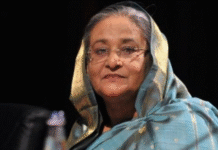Danish Ambassador in Dhaka Hanne Fugl Eskjær has used her house to promote a 200-year old dying Bangladeshi tradition of metal works.
The gorgeous display of Dhamrai Metal Crafts drew lot of attention in the art weekend that ended on Saturday.
Seven envoys from Brazil, Denmark, Germany, the Netherlands, Norway, Switzerland and Canada displayed different types of art works in their respective houses on Friday and Saturday, highlighting Bangladeshi artists.
The Brazil ambassador showcased miniature arts, while the German envoy displayed photographs; the Netherlands’ ambassador exhibited both photographs and sculptures; Norway and Canada’s envoys showcased paintings; and Switzerland’s diplomat exhibited photograph of a photojournalist.

“Bangladesh has an amazingly rich cultural heritage and you have something to be really proud of. You need to protect it,” the Danish ambassador told bdnews24.com at her house on Saturday, as she promoted the Dhamrai works.“Dhamrai Metal could be a centre for cultural artists. It can be a meeting place of arts. Bangladesh’s people should be proud of this and go to see the place,” she said.
A story of 200 years of struggle
“This is amazing,” Country Representative of the UN Women in Bangladesh Christine Hunter uttered as she looked at the metal crafts presenting a wedding procession of days of yore in Bangladesh in which Palanquin was used to carry the bride.
The statue of Nataraja (Hindu God Shiva), Lord Krishna, Durga, Tara, Radha and Krishna, Mahaveera, Sarospati, Parboti, Vishnu and Buddha were also on the display.
“We are carrying this through generations. I am the fifth generation in this family business,” Sukanta Banik, owner of Dhamrai Metal Crafts’ told bdnews24.com.

The business survived the 1947 partition of Indian sub-continent and later the 1971 war of independence when the house was looted.But the business is now dying, Banik said. “Even in 1990 we had 30 factories, now it dwindled to only three”.
The uniqueness of the business is that they use 5000-year old methods to craft the sculptures. The artisans use traditional handmade processes such as lost wax method, clay casting, sand casting and hammering.
There is no use of machine and artisans apply creativity to make the products. Every product is different as the mould cannot be used after a figure is sculpted. So duplication is not possible. It takes a month to make a sculpture.
“This form of art only exists in Bangladesh and we are getting tremendous response from North America, Europe and even from India,” Banik said, but the tardy bureaucracy made their business difficult.

“It takes even months to get clearance to send a sculpture,” he said, “and finally when we cannot send anything, we lose orders”.“The customs send our products to the department of archeology and the department then spends months to certify that we are not sending any archeological materials. This is ridiculous,” he lamented.
“We need government’s patronization to save this business,” he said.
Not well-known in Bangladesh
The Danish ambassador said she opened her house for the people to bring Bangladesh and Denmark closer.
She found many similarities with Danish artists but to her Bangladeshi art works were “more powerful and colourful”.

“Their works reflect the colour of Bangladesh,” she said, “which is something we should uphold and promote”.She, however, found that many Bangladeshis do not know about the Dhamrai centre’s work. “At least 50 percent of the foreigners know about this. But I found very few Bangladeshis know about this”.
Tara Rani Banik, mother of Sukanto, also agreed with the ambassador.
She recounted the struggle her family went through to keep the business alive.
“He (Sukanto) used to supply (his products) to Dhaka and manage his study in a local college. I gave him Tk 8,000 when he was 20 years old. I also helped him by giving the finishing touches of his sculptures.

“But it is very difficult now. I cannot even think of my grandchild doing the same business,” she said, “many foreigners helped us. But we did not get support from our own people in that way”.Sukanta also said they would be able to carry forward the business at best for the next two to three years. “Without local support, it is not possible to take it forward further. The number of artisans was also declining”.
Thanks to ambassadors
Artist Kanak Chanpa Chakma whose work was also on display at Danish ambassador’s residence told bdnews24.com that the ambassadors gave the Bangladeshi artists particularly the young ones a platform to display their works to the world.
“They are promoting our works. It’s really a wonderful opportunity. We must thank them,” she said, adding that art lovers were also growing in Bangladesh.
“We could not think 20 years ago that middle-class people would buy art works, but now they are buying. This is very positive trend.”
Source: bdnews24










